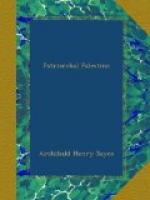But when he reached Canaan he was not yet Abraham. He was still “Abram the Hebrew,” and it was as “Abram the Hebrew” that he made alliance with the Amorites of Mamre and overthrew the retreating forces of the Babylonian kings. Abram—Abu-ramu, “the exalted father,”—is a Babylonian name, and is found in contracts of the age of Chedor-laomer. When the name was changed to Abraham, it was a sign that the Babylonian emigrant had become a native of the West.
It was under the terebinth of Moreh before Shechem that Abraham first pitched his tent and erected his first altar to the Lord. Above him towered Ebal and Gerizim, where the curses and blessings of the Law were afterwards to be pronounced. From thence he moved southward to one of the hills westward of Beth-el, the modern Beitin, and there his second altar was built. While the first had been reared in the plain, the second was raised on the mountain-slope.
But here too he did not remain long. Again he “journeyed, going on still towards the south.” Then came a famine which obliged him to cross the frontier of Egypt, and visit the court of the Pharaoh. The Hyksos kinsmen of the race to which he belonged were ruling in the Delta, and a ready welcome was given to the Asiatic stranger. He was “very rich in cattle, in silver and in gold,” and like a wealthy Arab sheikh to-day was received with due honour in the Egyptian capital. The court of the Pharaoh was doubtless at Zoan.
Among the possessions of the patriarch we are told were camels. The camel is not included among the Egyptian hieroglyphs, nor has it been found depicted on the walls of the Egyptian temples and tombs. The name is first met with in a papyrus of the time of the nineteenth dynasty, and is one of the many words which the Egyptians of that age borrowed from their Canaanitish neighbours. The animal, in fact, was not used by the Egyptians, and its domestication in the valley of the Nile seems to be as recent as the Arab conquest. But though it was not used by the Egyptians, it had been a beast of burden among the Semites of Arabia from an early period. In the primitive Sumerian language of Chaldaea it was called “the animal from the Persian Gulf,” and its Semitic name, from which our own word camel is derived, goes back to the very beginnings of Semitic history. We cannot, therefore, imagine a Semitic nomad arriving in Egypt without the camel; travellers, indeed, from the cities of Canaan might do so, but not those who led a purely nomadic life. And, in fact, though we look in vain for a picture of the camel among the sculptures and paintings of Egypt, the bones of the animal have been discovered deep in the alluvial soil of the valley of the Nile.




